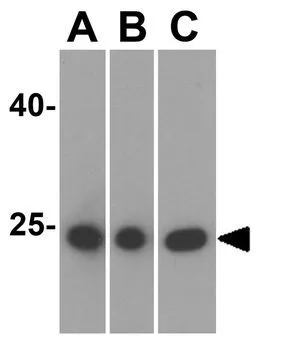Caspase 8 antibody
GTX110723
ApplicationsImmunoFluorescence, Western Blot, ImmunoCytoChemistry, ImmunoHistoChemistry, ImmunoHistoChemistry Paraffin
Product group Antibodies
ReactivityCanine, Feline, Human, Mouse, Rat
TargetCASP8
Overview
- SupplierGeneTex
- Product NameCaspase 8 antibody
- Delivery Days Customer9
- Application Supplier NoteWB: 1:500-1:3000. ICC/IF: 1:100-1:1000. IHC-P: 1:100-1:1000. *Optimal dilutions/concentrations should be determined by the researcher.Not tested in other applications.
- ApplicationsImmunoFluorescence, Western Blot, ImmunoCytoChemistry, ImmunoHistoChemistry, ImmunoHistoChemistry Paraffin
- CertificationResearch Use Only
- ClonalityPolyclonal
- Concentration1 mg/ml
- ConjugateUnconjugated
- Gene ID841
- Target nameCASP8
- Target descriptioncaspase 8
- Target synonymsALPS2B, CAP4, Casp-8, FLICE, MACH, MCH5, caspase-8, FADD-homologous ICE/CED-3-like protease, FADD-like ICE, ICE-like apoptotic protease 5, MACH-alpha-1/2/3 protein, MACH-beta-1/2/3/4 protein, MORT1-associated ced-3 homolog, apoptotic cysteine protease, apoptotic protease Mch-5, caspase 8, apoptosis-related cysteine peptidase, caspase 8, apoptosis-related cysteine protease
- HostRabbit
- IsotypeIgG
- Protein IDQ14790
- Protein NameCaspase-8
- Scientific DescriptionThis gene encodes a member of the cysteine-aspartic acid protease (caspase) family. Sequential activation of caspases plays a central role in the execution-phase of cell apoptosis. Caspases exist as inactive proenzymes composed of a prodomain, a large protease subunit, and a small protease subunit. Activation of caspases requires proteolytic processing at conserved internal aspartic residues to generate a heterodimeric enzyme consisting of the large and small subunits. This protein is involved in the programmed cell death induced by Fas and various apoptotic stimuli. The N-terminal FADD-like death effector domain of this protein suggests that it may interact with Fas-interacting protein FADD. This protein was detected in the insoluble fraction of the affected brain region from Huntington disease patients but not in those from normal controls, which implicated the role in neurodegenerative diseases. Many alternatively spliced transcript variants encoding different isoforms have been described, although not all variants have had their full-length sequences determined. [provided by RefSeq]
- ReactivityCanine, Feline, Human, Mouse, Rat
- Storage Instruction-20°C or -80°C,2°C to 8°C
- UNSPSC12352203
References
- Hsia Y, Sivasubramanian M, Chu CH, et al. A Dual Concentration-Tailored Cytokine-Chemo Nanosystem to Alleviate Multidrug Resistance and Redirect Balance of Cancer Proliferation and Apoptosis. Int J Nanomedicine. 2023,18:4253-4274. doi: 10.2147/IJN.S412932Read this paper
- Chen SM, Hee SW, Chou SY, et al. Activation of Aldehyde Dehydrogenase 2 Ameliorates Glucolipotoxicity of Pancreatic Beta Cells. Biomolecules. 2021,11(10). doi: 10.3390/biom11101474Read this paper
- Liang YH, Wu JM, Teng JW, et al. Embelin downregulated cFLIP in breast cancer cell lines facilitate anti-tumor effect of IL-1β-stimulated human umbilical cord mesenchymal stem cells. Sci Rep. 2021,11(1):14720. doi: 10.1038/s41598-021-94006-wRead this paper
- Xu H, Cai Y, Yu M, et al. Celastrol protects against early brain injury after subarachnoid hemorrhage in rats through alleviating blood-brain barrier disruption and blocking necroptosis. Aging (Albany NY). 2021,13(12):16816-16833. doi: 10.18632/aging.203221Read this paper
- Lam HYP, Liang TR, Peng SY. Ameliorative effects of Schisandrin B on Schistosoma mansoni-induced hepatic fibrosis in vivo. PLoS Negl Trop Dis. 2021,15(6):e0009554. doi: 10.1371/journal.pntd.0009554Read this paper
- Lam HYP, Chen CC, Chen TT, et al. Mitochondrial dynamics in Angiostrongylus cantonensis-infected mouse brain. Parasitol Int. 2021,80:102231. doi: 10.1016/j.parint.2020.102231Read this paper
- Lam HYP, Liang TR, Jiang SJ, et al. Albendazole-Schisandrin B Co-Therapy on Angiostrongylus cantonensis-Induced Meningoencephalitis in Mice. Biomolecules. 2020,10(7). doi: 10.3390/biom10071001Read this paper
- Elman JS, Ni TK, Mengwasser KE, et al. Identification of FUBP1 as a Long Tail Cancer Driver and Widespread Regulator of Tumor Suppressor and Oncogene Alternative Splicing. Cell Rep. 2019,28(13):3435-3449.e5. doi: 10.1016/j.celrep.2019.08.060Read this paper
- You BJ, Hour MJ, Chen LY, et al. Fenofibrate induces human hepatoma Hep3B cells apoptosis and necroptosis through inhibition of thioesterase domain of fatty acid synthase. Sci Rep. 2019,9(1):3306. doi: 10.1038/s41598-019-39778-yRead this paper
- Kao RH, Lai GM, Chow JM, et al. Opposite Regulation of CHOP and GRP78 and Synergistic Apoptosis Induction by Selenium Yeast and Fish Oil via AMPK Activation in Lung Adenocarcinoma Cells. Nutrients. 2018,10(10). doi: 10.3390/nu10101458Read this paper


![WB analysis of Wild-type (WT) and Caspase 8 knockout (KO) HeLa cell extracts using GTX01015 Caspase 8 antibody [GT1152]. Dilution : 1:1000 Loading : 25microg](https://www.genetex.com/upload/website/prouct_img/normal/GTX01015/GTX01015_20200327_WB_1_w_23053121_243.webp)

![WB analysis of HEK293 cell lysate using GTX30244 Caspase 8 antibody [FLICE 4-1-20]. Lanes 1 : inactive Caspase 8 Lane 2 : active Caspase 8 Dilution : 1:500](https://www.genetex.com/upload/website/prouct_img/normal/GTX30244/GTX30244_1376_WB_w_23060722_596.webp)

